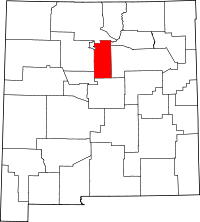Nambé Pueblo, New Mexico
|
Pueblo of Nambe | |
|
The Kiva | |
  | |
| Nearest city | Santa Fe, New Mexico |
|---|---|
| Coordinates | 35°53′5.26″N 105°57′52.29″W / 35.8847944°N 105.9645250°WCoordinates: 35°53′5.26″N 105°57′52.29″W / 35.8847944°N 105.9645250°W |
| Built | 1540 |
| NRHP Reference # | 74001208[1] |
| Added to NRHP | January 21, 1974 |
Nambé Oweenge Pueblo (/ˈnɑːmbeɪ/; Tewa: Nambe) is a pueblo in Santa Fe County, New Mexico, United States, located about 15 miles north of Santa Fe[2] at the base of the Sangre de Cristo Mountains in the Pojoaque Valley. The Pueblo of Nambé has existed since the 14th century. It was a primary cultural, economic, and religious center at the time of the arrival of Spanish colonists in the very early 17th century. The community of Nambe is separate from the pueblo. Nambé Pueblo is a member of the Eight Northern Pueblos.
Nambé was one of the Pueblos that organized and participated in the Pueblo Revolt of 1680, trying to expel the Spanish from the aera. The 2000 United States Census estimates the Nambé population at 558.[3]
Synonymy
Nambé is the Spanish version of a similar-sounding Tewa word, which can be interpreted loosely as meaning "rounded earth." The word "pueblo" stems from the Spanish word for "village." Pueblo refers both to the Southwestern style architecture and the people themselves.[2]
Population
The 2000 United States Census surveyed the Nambé Pueblo population at 558.[3] The entire population living at Nambé Pueblo, according to the 2010 United States Census, is 1,611.[4]
Language
The Nambé's language is a dialect of the Tewa language.[2]
History
Origin and early history
Scholars believe that all Pueblo peoples are descended from the Anasazi, possibly from the Mogollón, and other ancient peoples. As the Anasazi abandoned their canyon homeland due to social upheaval and climate change, they migrated to other areas. Eventually the Nambé emerged as a culture in their new homeland in present-day New Mexico.[2]
European contact
The Spanish conquistador Juan de Oñate arrived with armed forces in the area in 1598. He forced Nambé Pueblo, as was the case with other pueblos, to start paying him taxes with cotton, crops and labor. Catholic missionaries also came into the area, threatening native religious beliefs. They renamed pueblos with saints' names, and the first church was built in Nambé Pueblo in the early 1600s. The Spanish introduced new foods to the native communities, including peaches, peppers and wheat. In 1620 a royal decree assigned civil offices to each Pueblo.[2]
References
- ↑ National Park Service (2006-03-15). "National Register Information System". National Register of Historic Places. National Park Service.
- 1 2 3 4 5 Barry Pritzker (2000). A Native American Encyclopedia: History, Culture, and Ppeoples. Oxford University Press. p. 49. ISBN 978-0-19-513897-9. Retrieved 23 November 2011.
- 1 2 Census 2000 American Indian and Alaska Native Summary File (AIANSF) - Sample Data, Nambe alone (H46)
- ↑ 2010 Demographic Profile Data, Nambe Pueblo and Off-Reservation Trust Land, NM
External links
- Nambe Pueblo Official Website
- Nambe Pueblo
- Nambé Pueblo on New Mexico Tourism Department website
- Nambe Pueblo Pottery
- Nambe Falls and Lake recreation area

